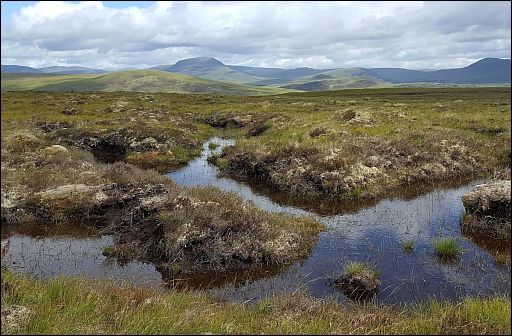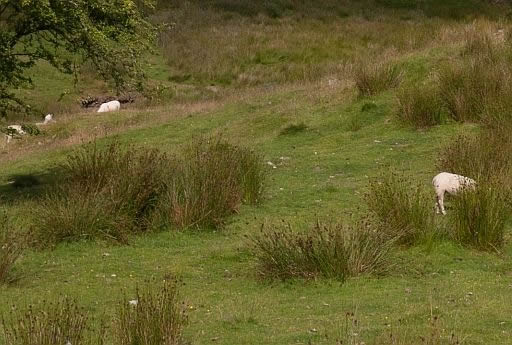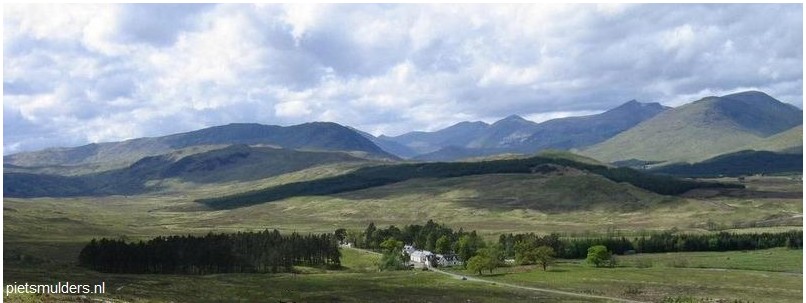
.
.......... UPLANDS IN SCHOTLAND
.
Upland:
= land lying above the limit of enclosed (omheind) farmland. Die grens ligt gewoonlijk op grofweg 1,000 feet (±300m) boven
zeeniveau.
Het is dus alles boven de Fell wall, m.a.w. de Open fell, dus de Outfield.
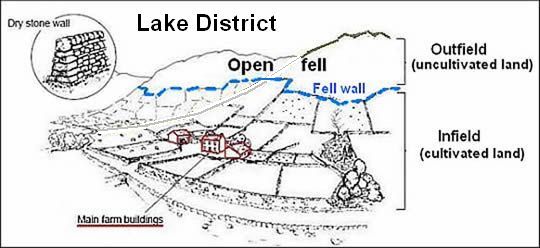
• Als voorbeeld een boerderij in het Lake District in Noord-Engeland.
• Het upland is de Open fell boven de Fell wall, dus de Outfield (het buitengebied, de wildernis, het onbewerkte gebied).
Infield-outfield farming:
Infield-outfield farming is broadly defined as a type of farming system utilizing its area at two different levels of intensity: an intensively farmed infield and an outfield exploited at a low intensity.
(In het Noors noemt men ze Innmark en Utmark)
![]() Infield = het binnengebied, d.w.z.
Infield = het binnengebied, d.w.z.
1. het bewerkte gebied (cultivated land; in cultuur gebrachte gebied).
2. dicht bij de boerderij.
De infield wordt intensief gebruikt. Denk aan ploegen, maaien, bemesten.
![]() Outfield = het buitengebied, de wildernis), d.w.z.
Outfield = het buitengebied, de wildernis), d.w.z.
1. het onbewerkte gebied (uncultivated land ; niet in cultuur gebrachte gebied),
2. ver van de boerderij.
De outfield wordt extensief gebruikt bijv. voor 't weiden van vee.
Ook in Nederland kenden we in het verleden infield-outfield farming. Denk aan het esdorpenlandschap, waar de essen(1) en de groenlanden (2) (de graslanden (wei- en hooilanden) in het beekdal) samen de infield vormden. De heide(3) was de outfield.
Upland habitats in Britain:
• Covering about a third of the UK’s land surface, upland habitats form the
bulk
of our wildest, most scenic and possibly most romantic countryside.
They are the open habitats of mountains,
moors (venen), blanket bogs (spreihoogvenen) , heaths and rough grasslands.
•The setting for many atmospheric novels from Wuthering Heights to
The Hound of the Baskervilles.
•The uplands are characterised by:
1. older, harder, more resistant rocks, which
form blocks of higher ground.
2. the soils are often less fertile making them less favourable for farming.
3. the climate, tends to be more severe.
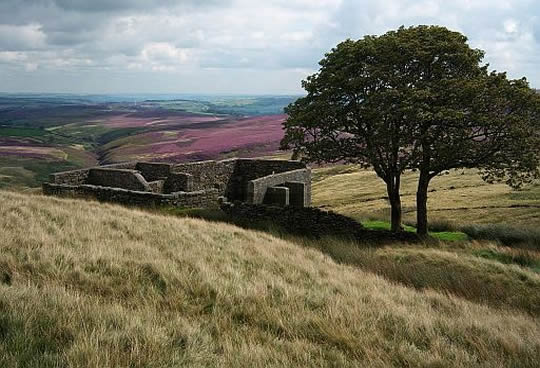
• Top Withens, Haworth Moor. This ruined farmhouse, is the supposed setting for Wuthering Heights in Emily Bronte's novel.
Krantenartikel:
George Monbiot: Why Britain's barren uplands have farming subsidies
to blame.
The hills have been grazed to destruction and it's time we
begin to
challenge
the irrational aspects of the farming funding system.
Zie: www.theguardian.com/e
Video ( 9 minuten):
George Monbiot: hills are 'sheep-wrecked' and in danger
Zie: www.youtube.com/watc
Mooie video: Rewilding (= herwildering) with George Monbiot:
George Monbiot:
Cross that bleak plateau and you will see plenty of moorgrass, some
tormentil
and moss, a few crows, perhaps the odd pipit and skylark, but
almost nothing
else, except sodding sheep. The hills have been grazed to
destruction'.
We zien een frappant verschil tussen de uplands van
het Europese
vasteland
en die van Groot-Brittannië (en Ierland).
Die van het continent zijn bebost (denk bijv. aan de Ardennen).
Dat is de normale gang van zaken bij uplands met hun relatief
ruige klimaat
en arme
bodem.
In Groot-Brittannië zijn ze echter niet bebost (denk aan de kale Pennines).
George Monbiot legt in een prachtige lezing uit hoe dat komt.
Warm aanbevolen.
Zie: www.youtube.com/watch?v=
...Rewilding (herwildering) = the mass restoration of ecosystems. |
.... Upland areas in Britain: Op de onderstaande kaart kun je de uplands goed vergelijken tussen Engeland, Schotland en Wales.
Schotland en Wales hebben beide relatief veel upland. In Schotland
is een groot
gedeelte daarvan zelfs boven de 2,500 ft (±760 m).
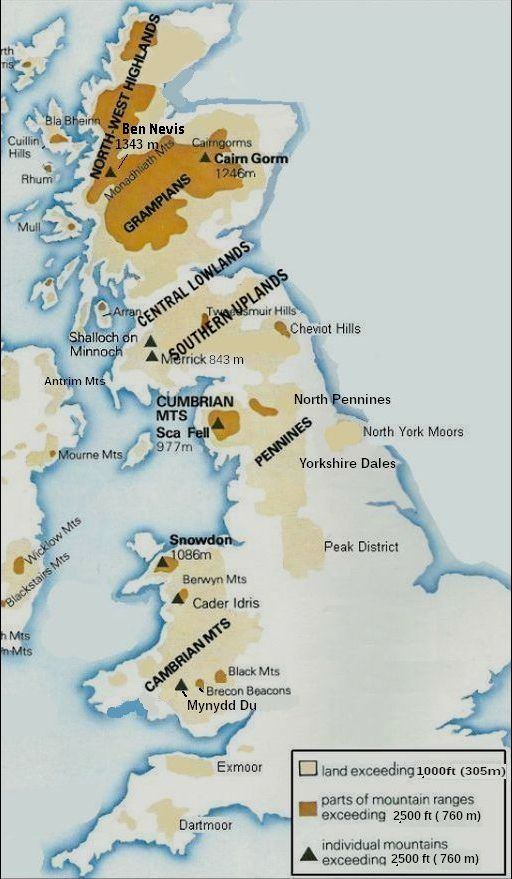 • De uplands zijn in de kaart de licht- en donkerbruine gebieden samen. • Most of our upland habitats are found in Scotland, Northern England and Wales, though there are some areas of moorland in South West England. • Towards the north of Britain the climate, soils and terrain become more challenging for plants and animals, so that some areas almost at sea level in Northern Scotland or the Hebrides still feel part of the upland rather. than the lowland zone..... |
| ... Suggested upland areas - James Fenton.. |
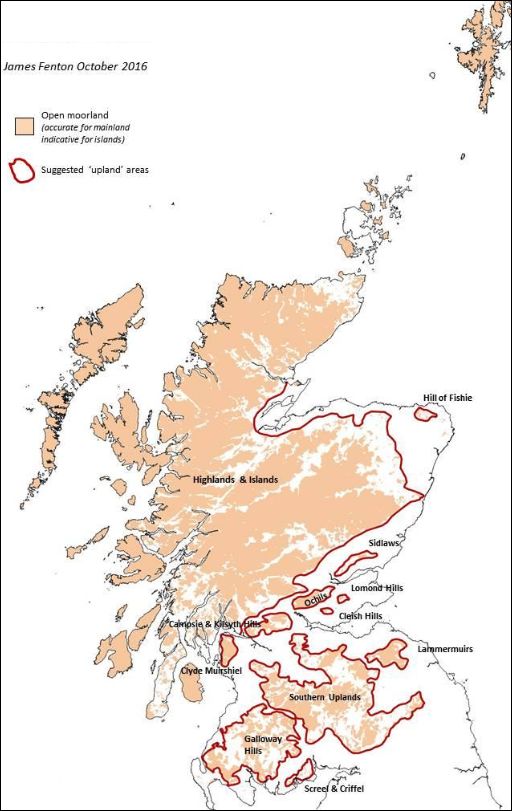
THE MAP INDICATES TWO BROAD CATEGORIES OF UPLAND:
TYPE A:
Large-scale landscapes with upland character throughout:
1. Highlands and Islands (hoogste top 1345 m)
2. Southern Uplands (hoogste top 843 m)
....(een heuvellandschap met het karakter van een middelgebergte).
3. Galloway Hills
(
Note: The Galloway Hills and Southern Uplands could be combined as
one unit, although there are differences between the two areas.)
TYPE B:
Localised hills arising above landscapes of intensive farmed or
urban
land:
(the last remaining moorland in lowland Scotland)
4. Hill of Fishie
5. Sidlaws
6. Ochils (hoogste top 720 m)
7. Lomond Hills (could include Benarty Hill)
8. Cleish Hills
9. Campsie, Kilsyth & Gargunnock Hills
10. Clyde Muirshiel Hills
11. Lammermuirs
12. Screel & Criffel
• Because the uplands are generally dominated by semi-natural moorland vegetation, and in the lowlands such moorland has been lost
through agricultural improvement, then the current location of moorland provides a good indication of landscapes of an upland character.
Hence it is suggested that the uplands here defined as landscapes where 'moorland is the dominant vegetation type' as delineated on the map.
Note:
There are areas in the north and west of Scotland that could be
described
as upland in character due to vegetation, but are at a low
altitude.
• This is not
a perfect definition because in some areas, particularly
Galloway and Argyll, forestry or woodland plantations now dominate a landscape
which would still naturally be moorland . Hence this map
includes these afforested areas.
• Additionally, there are some localities within the larger areas
of
‘uplands’
(Type A above) where there is a significant presence of agriculturally - improved land, such as Mainland Orkney or the
Campbeltown area
..... What are uplands ?
Although the word upland and this definition, implies an altitudinal
boundary,
the altitude (=hoogte) of the land is really a surrogate for climate, since the
position of the boundary between lowland and upland is related to the effect
that weather has
on plant growth. |
Important upland semi-natural habitats:
Most of the uplands have been modified through grazing, drainage,
tree-planting and deposits of atmospheric pollution.
The uplands are perhaps most memorable characterised by
a mosaic of bleak, open unenclosed(=niet omheind) landscape of:
1. Blanket bog (=spreihoogveen),
2. Upland Heaths,
3. Upland Grassland
.....1. Blanket bog (=spreihoogveen): As the name suggests, blanket bogs form over a large area and are
typically
shallow (a few metres). Blanket bog (=spreihoogveen): is an open habitat almost entirely restricted to the uplands in England and Wales, but which descends to sea level in parts of
Scotland.
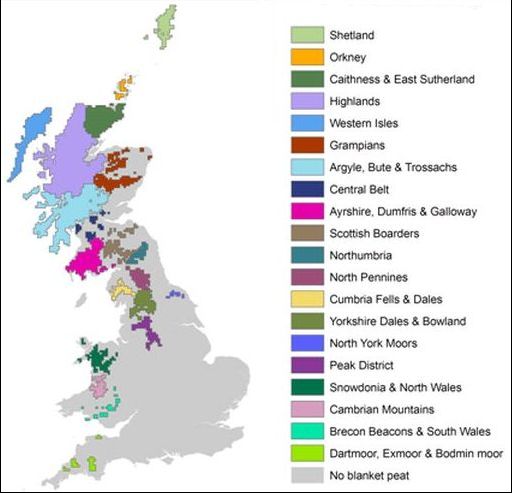 • Blanket bogs by region based on 5 km gridded data of blanket peat presence. |
.... 2. Upland heaths : 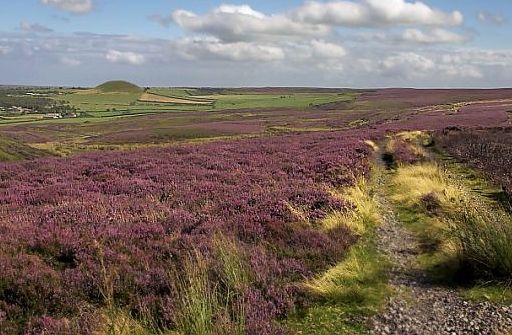 • Upland heath ( heather moor) in the North York Moors. • Het is niet omheind (unenclosed) heideveen dat beheerd wordt voor grouse shooting. . Upland heath occurs on steeper slopes than blanket bog. It occurs on mineral soils and thin peats < 0.5 m, and is characterised by a cover of dwarf shrubs of at least 25%. (Blanket bog is distinguished from heathland by its occurrence on deep peat (> 0.5m) and gentler slopes.) Typical shrub species include: - Heather (Calluna vulgaris) (Struikhei), - Bilberry (Vaccinium myrtillus) (Blauwe bosbes), - Crowberry (Empetrum nigrum) (Kraaihei) and - Bell heather (Erica cinerea) (Rode dophei). - Juniper (Jeneverbes) is often found on upland heaths in northern areas, whilst - Western gorse (Ulex gallii) (Westelijke gaspeldoorn) occurs in the south and west. Wet heath is more commonly found in the north and west where the climate is damper. Here typical plant species are: - Cross-leaved heath (Erica tetralix) (Gewone dophei), - Deer grass (Scirpus cespitosus) (een Bies-soort), - Heather and Purple moor grass (Molinia caerulea) (Pijpenstrootje) , - with a carpet of mosses including Sphagnum species. (Veenmos spp) http://www.peakdistrict.gov.uk .... |
.... 3. Upland grassland:
Upland grasslands are the result of human intervention through
livestock grazing. |
De uplands zijn ecologisch niet gezond:
Het bos op de Schotse Hooglanden sterft uit.
Bejaarde bomen gaan dood en jonge bomen worden opgegeten.
In tegenstelling tot wat veel mensen denken, heeft Schotland er niet altijd
zo kaal uitgezien. Aan het begin van de Middeleeuwen waren grote delen
van het land nog bedekt door de voor Schotland karakteristieke grove den,
en ook loofbomen als ratelpopulier, wilg, eik en berk.
Maar de bevolking groeide, en daarmee ook de behoefte aan hout om
huizen te bouwen, en die warm te houden. De bossen moesten ook plaats maken
voor landbouwgrond.
Toen Schotland daarnast nog maritieme ambities kreeg, was de kaalslag
helemaal niet meer te stoppen. Er werd jacht gemaakt op de laatste
grove dennen, die essentieel waren voor de scheepsbouw.
Van die maritieme ambities is niet veel gekomen, uiteindelijk moest
Schotland het onderspit delven tegen zuiderbuur Engeland.
Tijdens de zogenaamde highland clearances in de achttiende en
negentiende eeuw verdwenen naast de bomen ook de mensen.
Onder druk van de Engelsen werden hele Schotse gemeenschappen
gedeporteerd naar de kust.
Op de Schotse highlands lieten de Engelsen schapen los die het gebied
vakkundig leegvraten en uitputten. Wat overbleef, waren de crofts,
in onderpacht bewerkte gronden, en hier en daar een boom die alles
door
een mirakel had overleefd. Alleen op afgelegen plekken, steile
berghellingen die niet interessant waren voor de landbouw,
overleefden
kleine plukjes bos.
Tegenwoordig vormen niet alleen schapen een probleem.
Er zijn daarnaast ook nog 400.000
edelherten.
![]() The uplands are an inherently infertile region,
The uplands are an inherently infertile region,
- devastated by deforestation and repeated burning,
- largely depopulated and then
- opened to heavy and uncontrolled sheep grazing.
![]() Bringing them back into a good ecological health means reduction of deer numbers, grouse moors and sheep farming.
Bringing them back into a good ecological health means reduction of deer numbers, grouse moors and sheep farming.
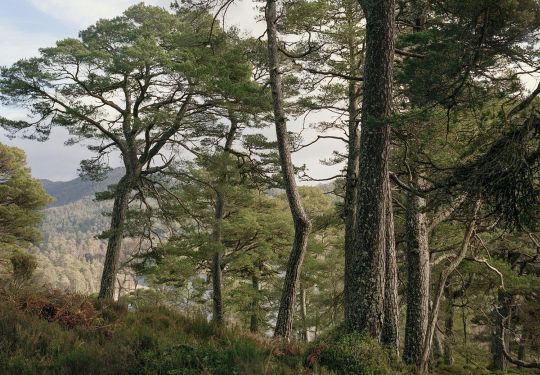
• Glen Affric, beschermd gebied. Zo moet Schotland er vroeger uit hebben gezien.
Weet je aanvullingen en verbeteringen van deze tekst?
Graag een e-mail naar:
![]()
LAATST BIJGEWERKT : 7-1-2019
